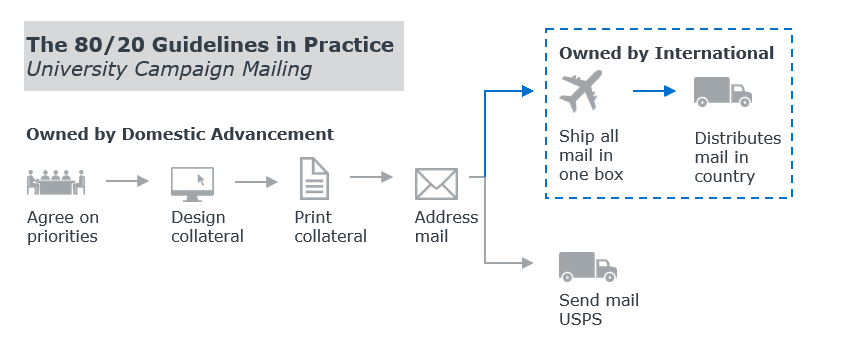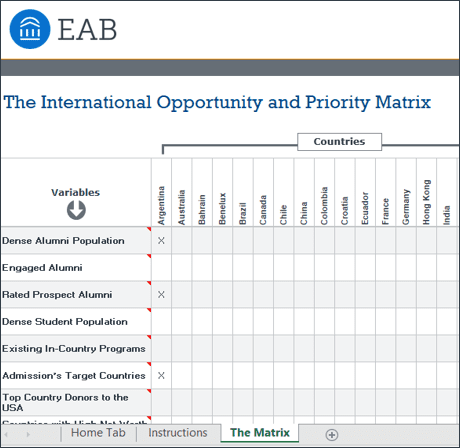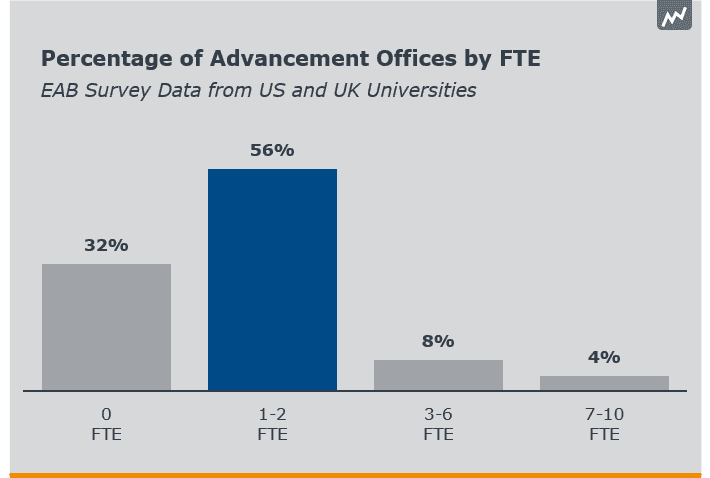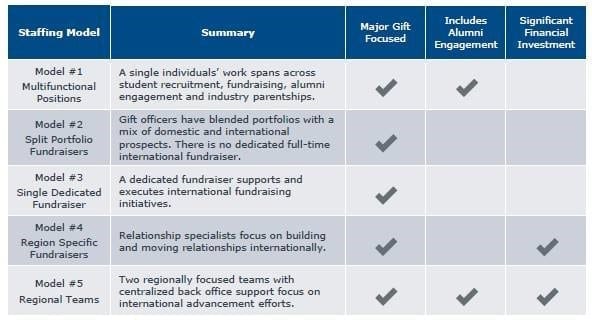Engaging International Alumni and Prospects
International Fundraising on the Rise
Urgency for Engaging Alumni and Prospects Abroad Grows
To meet ever-growing campaign goals and fill budget gaps, advancement leaders have realized their domestic fundraising strategies aren’t enough. Many universities have started to look abroad for additional philanthropic revenue.
In recent years, international fundraising has become more attractive to higher education advancement because of an increase in international students with enrollment growing from 2008 to 2016.
104%

28%

At the same time, the burgeoning ranks of millionaires abroad offer universities an untapped pool of major and principal gift level prospects.
| # of Millionaires | Nat’l Wealth (USD) | |
| Japan | 2.8 Million | $30 Trillion |
| China | 1.6 Million | $35 Trillion |
| Germany | 1.6 Million | $9.7 Trillion |
| France | 1.6 Million | $6.6 Trillion |
| Australia | 1.1 Million | $6.1 Trillion |
Sources: Neil Ruiz and Jynnah Radford, “New Foreign Student Enrollment at U.S. Colleges and Universities Doubled Since Great Recession,” Pew Research Center, November 20, 2017.; Universities UK International, “International Facts and Figures,” May, 2017.; Derek Scissors, “Is China’s Economic Power a Paper Tiger?” The National Interest, November 27, 2017.; Elizabeth Redden, “For International Students, Shifting Choices of Where to Study,” August 24, 2018.; Alex Morell, “The 18 Countries with the Most Millionaires,” April 18, 2017. Jeff Desjardins, “Ranked: The 10 Wealthiest Countries in the World,” May 4, 2018.
Top Challenges for International Advancement
Staffing Models and Organizational Structures
While the numbers are attractive, there are a variety of challenges around engaging international alumni and prospects, ranging from identification to data verification to cultural sensitivities and knowledge gaps. To better understand the key pain points, EAB surveyed universities interested in international fundraising to surface the hurdles and roadblocks leaders face today.
Staffing was the top challenge for the majority of surveyed universities. For many advancement leaders, international fundraising is a new terrain, and the largest research need was around staffing models and organizational structures.
“Fundraising internationally is a priority for us, but because it’s a new terrain not many other offices have programs yet. We are still searching for a practical staffing model before we do anything in the space.“
Chief Advancement Officer
Private Research University
76%

To meet the needs of universities, EAB’s Advancement Forum dedicated research resources to auditing the international landscape. The following document presents tactics for developing an international fundraising program and the five primary staffing models found across higher
education universities.
Laying the Groundwork for an International Launch
Identifying High-ROI Markets
Sizing the Opportunity
With a rapidly globalizing world and alumni spread far and wide, it’s critical to size the opportunities for advancement internationally. Scoping opportunities and prioritizing regions helps universities avoid misaligned and unproductive investments.
Related resource
Download the International Opportunity and Priority Matrix
Download the ToolThe University of Wisconsin-Madison developed a priority matrix to systematically assess international opportunities before developing programming. The matrix organizes variables to consider, such
as alumni engagement, number of high net-worth individuals, and top countries currently making donations.
Staff at the University of Wisconsin-Madison used the matrix to gain support for their international plans and to outline the potential ROI of investing in particular regions to university leaders. The matrix also identified key campus partners to collaborate with in the future, such as admissions.
Priority Matrix Analysis Has Multiple Uses for Advancement
- Show university leaders the potential ROI
- Identifies key campus partners and university stakeholders
- Helps align division goals, strategies, and resources
International Opportunity and Priority Matrix
Prioritizing Our Opportunities
Considerations for Integrating an International Program in Advancement
While the priority matrix helps advancement leaders identify potential regions and countries for international development, The University of Notre Dame’s feasibility framework allows institutions to further drill down to determine areas with the highest ROI.
Notre Dame’s feasibility framework revolves around three key questions:

- Where is the university already?
Consider where university support already exists locally:
- Study abroad programs
- Enrollment office relationships
- Affiliated individuals of influence
- Strong and active alumni groups and clubs

2. Where does the university want to be?
Find stakeholders who want to engage a country or region:
- Faculty
- Students
- Enrollment
- Athletics

3. Where is the university relevant?
Assess the relevancy of the university in a specific region or country:
- Alignment with the university’s mission
- The university has local measurable impact
- Local individuals have a desire to financially support the university
Increase alumni engagement without new programs
Build a single platform that curates and highlights diversity-related programming.
Download the ToolThe first question, “Where is the university already?” helps to evaluate networks and university functions already in existence that advancement can utilize. For example, if the university has a study abroad program in Beijing, advancement can use the university facilities there during in-country visits. The second question, “Where does the university want to be?” will assist advancement in identifying stakeholders who may be willing to serve as a partner abroad. The last question, “Where is the university relevant?” helps determine potential in-country supporters and key networks.
Don’t Reinvent the Wheel
Successful Programs Build on Scale and Efficiency
Moving from evaluating the feasibility of a program to the development of systems and processes requires an assessment of current advancement functions. Finding efficiencies within current structures increases the potential ROI made from international fundraising efforts.

At Notre Dame, a set of guidelines establishes the expectation that 80% of international fundraising processes must align with existing domestic advancement practices. For example, the international unit may not need to create, design, or print unique university campaign mailings for international constituents. Instead, central advancement prepares the mailing, and before it is sent to USPS, the international unit intercepts the mail and sends it in a unique, cost-effective way to international constituents. Notre Dame’s 80/20 guidelines build and encourage a sustainable international advancement function.
A Standardized, Surprise-Free Process
Codify Gift Acceptance Rules and Elevate Outliers
The political landscape of international donations is volatile and can be a source of tension for international advancement programs. Media outlets and stakeholders have begun to highlight and question universities accepting gifts from particular countries, regions, and individuals.
“We’re continuously looking at other universities and non-profits who are having international fundraising success. We’ve been monitoring gifts coming in and we’ve notice a trend of negative headlines about gifts from similar regions we’re getting donations from. So we’re talking about potential issues and what to do about them before they happen. That way if something does happen we’re ready to handle it.”
Chief Advancement Officer
Private Research University
To reduce the stress on the international advancement program and individual gift officers, universities are beginning to proactively codify gift acceptance rules for international donations. Codifying rules for an international gift first involves identifying stakeholders that can thoughtfully consider both international and domestic contexts. Next, the group of stakeholders can develop a set of rules taking into consideration factors such as international and domestic laws.
Operating in a fast-paced global market
means there may be international gifts that don’t clearly fall into established
gift acceptance rules. If an outlier is presented to a gift officer, they may
not be best equipped to make
a decision on
behalf of the university. To tackle outliers and the potential challenges they
may pose to the university, it’s critical to have a committee prepared to
handle
the situation.

Staffing Structures for Fundraising and Engagement
The Current International Staffing Landscape
EAB Survey Results
International programs are becoming more common in higher education advancement. EAB survey data found that if universities do have full-time staff focusing on international efforts, it is most likely one to two individuals.
Offices with one or two internationally-focused staff typically have these individuals working specifically on development efforts. EAB data showed that it is less common to have a full-time staff member dedicated to international alumni relations.
Five Staffing Models for International Fundraising
EAB research identified five primary staffing models used across higher education universities in the United States and the United Kingdom to fundraise internationally. The staffing models in the summary table below are elaborated on in the following pages.
Model 1: Multifunctional Positions – University of Edinburgh
The University of Edinburgh’s international efforts have been supported by regional directors for various lengths of time depending on the region. For example, offices opened in 2010 in India, in 2013 in South America, and in 2014 in North America.
Model 2: Split Portfolios – Case Western Reserve University
Case Western Reserve University began its international fundraising via split portfolios efforts twelve years ago in the engineering school. The split portfolio model is still in place with future plans to move towards a dedicated staff member.
Model 3: Single Dedicated Fundraiser – Penn State University
International fundraising efforts at Penn State University began 18 months ago with the hiring of the Director of International Development. In the future, the director hopes to grow the team to fundraise in more regions worldwide.
Model 4: Region Specific Fundraisers – Massachusetts Institute of Technology (MIT)
MIT’s international fundraising program started 25 years ago in a single country. Over the last few decades, the program slowly expanded and now includes a total of five regions. Currently, this team does not plan to hire more fundraisers but remains open to transferring individuals internally to meet international fundraising needs.
Model 5: Regional Teams – Carnegie Mellon University
Carnegie Mellon started its international efforts in 2003 with one dedicated fundraiser. In 2015, an international team was created to expand the university’s international development efforts. The current team includes 5.5 full-time staff. Future plans may include growing the team to reduce the number of unassigned prospects.
This resource requires EAB partnership access to view.
Access the research report
Learn how you can get access to this resource as well as hands-on support from our experts through Advancement Advisory Services.
Learn More

